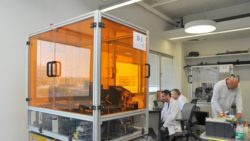1. Please share your story on the journey towards Technology Adoption.
Nano Dimension took an incredible task to 3D print multi-layer electronics, this was the dream of many people before, the main challenge for printing electronics is that you need to print 2 materials at the same time, and not only 2 materials but with very different properties- one is conductive and the other is dielectric.It took us few years and people were skeptical that it is even possible, but we have succeeded in this and have a great product. We started our commercial sales of DragonFly 2020 pro since late 2017 and we have a great momentum.

2. How do you think 3D printing has improved and impacted the quality of people’s life?
It opens up new design possibilities in the wearable, medical, IOT, autonomous cars and can improve almost any product that uses electronics, it allows product to be 3D shaped to fit into our needs, today electronics can be very small but only 2D.
3. What do you think the future of 3D printing holds? What new developments can we expect in the next 5 years?
The next 5 years will be exciting, a shift from mass production to mass customization is starting to happen, our shoes, cloths, furniture, electronics and some medical such as dental 3D printing will evolve quickly.
4. What does 3D Printing mean to you and to your business success?
As the first company to create professional 3D printed multi-layer electronics we are very excited about 3D Printing, we are very lucky to be among the pioneers to reinvent the electronics industry.
5. What new business opportunities, can we look forward to in Industry 4.0, especially in your industry?
The shift from designing 2 different parts for an electronic product, one team create electronics and the other create mechanical, both are using different tools and design methods, 3D printed electronics can allow us to create one design that include mechanical and electronics, this opens up a totally new way to look at products. Also, 3D printing can allow company to develop much faster and protect their IP, can give them an amazing advantage.

6. From your experience, what are the limitations/roadblocks for companies using Additive Manufacturing and what advise will you give to startups wanting jump on the bandwagon?
The biggest challenge is that when people are getting excited and understand the potential they immediately want the technology to replace current mass production methods, and as a new technology it is now ready for prototyping and small scale production and will require some more time before it will be ready to mass production.
I would recommend to every start up in this space to find the new applications that customers can accept today, develop what people can use today and grow as the technology evolve and always look at your customers.
7. Is 3D Printing the game changer for the Industrial revolution 4.0 and is it here to stay for the long haul?
Absolutely! We see a 3D printing with similar properties to film photography and the shift to digital photography, it can disrupt very solid companies and changes people life for the better.

